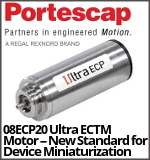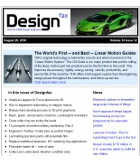 |
| February 20, 2024 | Volume 20 Issue 07 |
Motion Control News & Products
Designfax weekly eMagazine
Archives
Partners
Manufacturing Center
Product Spotlight
Modern Applications News
Metalworking Ideas For
Today's Job Shops
Tooling and Production
Strategies for large
metalworking plants
Linear guide system corrects misalignments
 Bishop-Wisecarver's UtiliTrak® linear guide system includes vee rails for precision and open rails for misalignment float to provide smooth and accurate motion on inaccurate structures. Because precise parallelism is difficult to achieve, it is not uncommon for mounting surfaces to be slightly out of parallel. UtiliTrak's design compensates for mounting errors and does not require absolute parallelism for accurate operation. Genius.
Bishop-Wisecarver's UtiliTrak® linear guide system includes vee rails for precision and open rails for misalignment float to provide smooth and accurate motion on inaccurate structures. Because precise parallelism is difficult to achieve, it is not uncommon for mounting surfaces to be slightly out of parallel. UtiliTrak's design compensates for mounting errors and does not require absolute parallelism for accurate operation. Genius.
Learn more.
Universal Robots emerges as preferred robotics platform for AI solutions at Automate 2024
 At North America's largest automation show (Chicago, May 6-9), cobot pioneer Universal Robots will redefine the frontiers of physical AI, showcasing how the "ChatGPT moment for robots" has arrived in a wide range of applications. Automate attendees will also experience how Universal Robots' newest cobot models, the UR20 and UR30, automate tasks with increased payload, reach, and torque.
At North America's largest automation show (Chicago, May 6-9), cobot pioneer Universal Robots will redefine the frontiers of physical AI, showcasing how the "ChatGPT moment for robots" has arrived in a wide range of applications. Automate attendees will also experience how Universal Robots' newest cobot models, the UR20 and UR30, automate tasks with increased payload, reach, and torque.
Learn more.
Multi-stage mini vacuum pumps: Max performance
 Designed to meet the demanding needs of industrial users, the CMS M series mini vacuum pump from COVAL combines robustness, performance, and modularity, offering an optimum solution for applications requiring high suction flow rates, such as gripping porous parts, emptying tanks, or material handling when integrated into vacuum grippers. Thanks to their ultra-compact design and optimized multi-stage Venturi system, these pumps guarantee powerful suction flows up to 19.42 SCFM, while reducing compressed air consumption in a compact footprint.
Designed to meet the demanding needs of industrial users, the CMS M series mini vacuum pump from COVAL combines robustness, performance, and modularity, offering an optimum solution for applications requiring high suction flow rates, such as gripping porous parts, emptying tanks, or material handling when integrated into vacuum grippers. Thanks to their ultra-compact design and optimized multi-stage Venturi system, these pumps guarantee powerful suction flows up to 19.42 SCFM, while reducing compressed air consumption in a compact footprint.
Learn more.
Choosing a stepper motor: PM or hybrid?
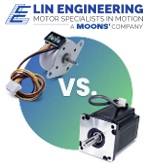 Lin Engineering stepper motors are widely used in various applications that require precise control of motion, such as in robotics, 3D printing, CNC machines, and medical equipment. There are two main types of stepper motors: permanent magnet (PM) and hybrid. Learn the differences, advantages, and when to use one type or the other.
Lin Engineering stepper motors are widely used in various applications that require precise control of motion, such as in robotics, 3D printing, CNC machines, and medical equipment. There are two main types of stepper motors: permanent magnet (PM) and hybrid. Learn the differences, advantages, and when to use one type or the other.
Read this informative Lin Engineering article.
Top Product: Integrated servo system is 20% smaller than standalone unit
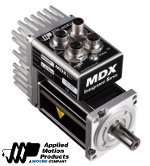 Applied Motion Products has introduced the MDX+ series, a family of low-voltage servo systems that integrate a servo drive, motor, and encoder into one package. This all-in-one drive unit is an ideal solution for manufacturers in logistics, AGV, medical, semiconductor, the solar industries, and many others.
Applied Motion Products has introduced the MDX+ series, a family of low-voltage servo systems that integrate a servo drive, motor, and encoder into one package. This all-in-one drive unit is an ideal solution for manufacturers in logistics, AGV, medical, semiconductor, the solar industries, and many others.
Read the full article.
Overhung load adaptors provide load support and contamination protection
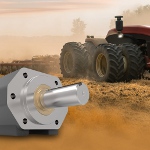 Overhung load adaptors (OHLA) provide both overhung radial and axial load support to protect electrified mobile equipment motors from heavy application loads, extending the lifetime of the motor and alleviating the cost of downtime both from maintenance costs and loss of production. They seal out dirt, grime, and other contaminants too. Zero-Max OHLAs are available in an extensive offering of standard models (including Extra-Duty options) for typical applications or customized designs.
Overhung load adaptors (OHLA) provide both overhung radial and axial load support to protect electrified mobile equipment motors from heavy application loads, extending the lifetime of the motor and alleviating the cost of downtime both from maintenance costs and loss of production. They seal out dirt, grime, and other contaminants too. Zero-Max OHLAs are available in an extensive offering of standard models (including Extra-Duty options) for typical applications or customized designs.
Learn more.
Why choose electric for linear actuators?
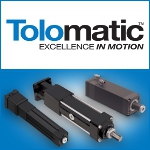 Tolomatic has been delivering a new type of linear motion technology that is giving hydraulics a run for its money. Learn the benefits of electric linear motion systems, the iceberg principle showing total cost of ownership, critical parameters of sizing, and conversion tips.
Tolomatic has been delivering a new type of linear motion technology that is giving hydraulics a run for its money. Learn the benefits of electric linear motion systems, the iceberg principle showing total cost of ownership, critical parameters of sizing, and conversion tips.
Get this informative e-book. (No registration required)
New AC hypoid inverter-duty gearmotors
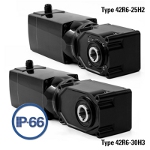 Bodine Electric Company introduces 12 new AC inverter-duty hypoid hollow shaft gearmotors. These type 42R-25H2 and 42R-30H3 drives combine an all-new AC inverter-duty, 230/460-VAC motor with two hypoid gearheads. When used with an AC inverter (VFD) control, these units deliver maintenance-free and reliable high-torque output. They are ideal for conveyors, gates, packaging, and other industrial automation equipment that demands both high torque and low power consumption from the driving gearmotor.
Bodine Electric Company introduces 12 new AC inverter-duty hypoid hollow shaft gearmotors. These type 42R-25H2 and 42R-30H3 drives combine an all-new AC inverter-duty, 230/460-VAC motor with two hypoid gearheads. When used with an AC inverter (VFD) control, these units deliver maintenance-free and reliable high-torque output. They are ideal for conveyors, gates, packaging, and other industrial automation equipment that demands both high torque and low power consumption from the driving gearmotor.
Learn more.
Next-gen warehouse automation: Siemens, Universal Robots, and Zivid partner up
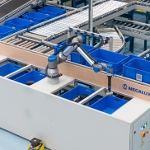 Universal Robots, Siemens, and Zivid have created a new solution combining UR's cobot arms with Siemens' SIMATIC Robot Pick AI software and Zivid's 3D sensors to create a deep-learning picking solution for warehouse automation and intra-logistics fulfillment. It works regardless of object shape, size, opacity, or transparency and is a significant leap in solving the complex challenges faced by the logistics and e-commerce sectors.
Universal Robots, Siemens, and Zivid have created a new solution combining UR's cobot arms with Siemens' SIMATIC Robot Pick AI software and Zivid's 3D sensors to create a deep-learning picking solution for warehouse automation and intra-logistics fulfillment. It works regardless of object shape, size, opacity, or transparency and is a significant leap in solving the complex challenges faced by the logistics and e-commerce sectors.
Read the full article.
Innovative DuoDrive gear and motor unit is UL/CSA certified
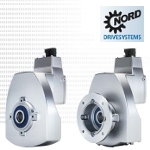 The DuoDrive integrated gear unit and motor from NORD DRIVE-SYSTEMS is a compact, high-efficiency
solution engineered for users in the fields of intralogistics, pharmaceutical, and the food and beverage industries. This drive combines a IE5+ synchronous motor and single-stage helical gear unit into one compact housing with a smooth, easy-to-clean surface. It has a system efficiency up to 92% and is available in two case sizes with a power range of 0.5 to 4.0 hp.
The DuoDrive integrated gear unit and motor from NORD DRIVE-SYSTEMS is a compact, high-efficiency
solution engineered for users in the fields of intralogistics, pharmaceutical, and the food and beverage industries. This drive combines a IE5+ synchronous motor and single-stage helical gear unit into one compact housing with a smooth, easy-to-clean surface. It has a system efficiency up to 92% and is available in two case sizes with a power range of 0.5 to 4.0 hp.
Learn more.
BLDC flat motor with high output torque and speed reduction
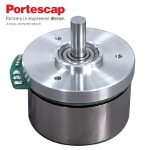 Portescap's 60ECF brushless DC slotted flat motor is the newest frame size to join its flat motor portfolio. This 60-mm BLDC motor features a 38.2-mm body length and an outer-rotor slotted configuration with an open-body design, allowing it to deliver improved heat management in a compact package. Combined with Portescap gearheads, it delivers extremely high output torque and speed reduction. Available in both sensored and sensorless options. A great choice for applications such as electric grippers and exoskeletons, eVTOLs, and surgical robots.
Portescap's 60ECF brushless DC slotted flat motor is the newest frame size to join its flat motor portfolio. This 60-mm BLDC motor features a 38.2-mm body length and an outer-rotor slotted configuration with an open-body design, allowing it to deliver improved heat management in a compact package. Combined with Portescap gearheads, it delivers extremely high output torque and speed reduction. Available in both sensored and sensorless options. A great choice for applications such as electric grippers and exoskeletons, eVTOLs, and surgical robots.
Learn more and view all the specs.
Application story: Complete gearbox and coupling assembly for actuator system
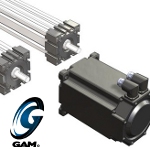 Learn how GAM engineers not only sized and selected the appropriate gear reducers and couplings required to drive two ball screws in unison using a single motor, but how they also designed the mounting adapters necessary to complete the system. One-stop shopping eliminated unnecessary components and resulted in a 15% reduction in system cost.
Learn how GAM engineers not only sized and selected the appropriate gear reducers and couplings required to drive two ball screws in unison using a single motor, but how they also designed the mounting adapters necessary to complete the system. One-stop shopping eliminated unnecessary components and resulted in a 15% reduction in system cost.
Read this informative GAM blog.
Next-gen motor for pump and fan applications
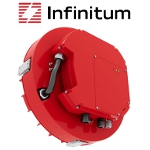 The next evolution of the award-winning Aircore EC motor from Infinitum is a high-efficiency system designed to power commercial and industrial applications such as HVAC fans, pumps, and data centers with less energy consumption, reduced emissions, and reduced waste. It features an integrated variable frequency drive and delivers upward of 93% system efficiency, as well as class-leading power and torque density in a low-footprint package that is 20% lighter than the previous version. Four sizes available.
The next evolution of the award-winning Aircore EC motor from Infinitum is a high-efficiency system designed to power commercial and industrial applications such as HVAC fans, pumps, and data centers with less energy consumption, reduced emissions, and reduced waste. It features an integrated variable frequency drive and delivers upward of 93% system efficiency, as well as class-leading power and torque density in a low-footprint package that is 20% lighter than the previous version. Four sizes available.
Learn more.
Telescoping linear actuators for space-constrained applications
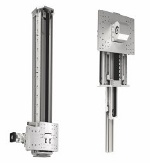 Rollon's new TLS telescoping linear actuators enable long stroke lengths with minimal closed lengths, which is especially good for applications with minimal vertical clearance. These actuators integrate seamlessly into multi-axis systems and are available in two- or three-stage versions. Equipped with a built-in automated lubrication system, the TLS Series features a synchronized drive system, requiring only a single motor to achieve motion. Four sizes (100, 230, 280, and 360) with up to 3,000-mm stroke length.
Rollon's new TLS telescoping linear actuators enable long stroke lengths with minimal closed lengths, which is especially good for applications with minimal vertical clearance. These actuators integrate seamlessly into multi-axis systems and are available in two- or three-stage versions. Equipped with a built-in automated lubrication system, the TLS Series features a synchronized drive system, requiring only a single motor to achieve motion. Four sizes (100, 230, 280, and 360) with up to 3,000-mm stroke length.
Learn more.
Competitively priced long-stroke parallel gripper
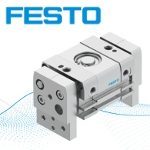 The DHPL from Festo is a new generation of pneumatic long-stroke grippers that offers a host of advantages for high-load and high-torque applications. It is interchangeable with competitive long-stroke grippers and provides the added benefits of lighter weight, higher precision, and no maintenance. It is ideal for gripping larger items, including stacking boxes, gripping shaped parts, and keeping bags open. It has high repetition accuracy due to three rugged guide rods and a rack-and-pinion design.
The DHPL from Festo is a new generation of pneumatic long-stroke grippers that offers a host of advantages for high-load and high-torque applications. It is interchangeable with competitive long-stroke grippers and provides the added benefits of lighter weight, higher precision, and no maintenance. It is ideal for gripping larger items, including stacking boxes, gripping shaped parts, and keeping bags open. It has high repetition accuracy due to three rugged guide rods and a rack-and-pinion design.
Learn more.
Can EV motors have second lives? Fraunhofer Institute working on it

The REASSERT project aims to develop a prototype electric motor for the circular economy. [Credit: © Schaeffler/Fraunhofer Institute for Manufacturing Engineering and Automation IPA]
An increasing number of electric vehicles (EVs) are being sold, consequently raising the quantity of produced electric motors. At the end of their useful life, these electric motors are usually shredded and then recycled. The individual components and assemblies cannot be reused.
So far, there has been a lack of sustainable value retention strategies for remanufacturing and recycling electric motors as part of a modern circular economy. In the REASSERT project, researchers at the Fraunhofer Institute for Manufacturing Engineering and Automation IPA are working alongside industry partners to pursue various concepts for repairing, remanufacturing, and reusing electric motors, as well as new designs for the circular economy.
The electric motors used in EVs contain valuable raw materials such as copper as well as rare earth metals like neodymium, where China holds a quasi-monopoly, and which cannot be recovered with current recycling methods. Hence, extending the usage phase of the motors is increasingly important. Furthermore, the raw materials used have a bigger carbon footprint compared to a combustion engine. Because of this, it is crucial to extend the use phase of these motors.
"Innovative value retention strategies offer significant potential for emission reduction in terms of sustainability," says Julian Grobe Erdmann, scientist at the Fraunhofer Institute for Manufacturing Engineering and Automation IPA in Bayreuth, Germany. As part of the REASSERT project, researchers are collaborating with Schaeffler (consortium leader), the Karlsruhe Institute of Technology, BRIGHT Testing GmbH, iFAKT GmbH, and Riebesam GmbH & Co. KG to develop innovative methods for remanufacturing electric motors and reusing them in vehicles. They are focusing on the value retention strategies of reuse, repair, remanufacture, and raw material recycling. These are key elements for a circular economy, enabling the reduction of natural resource consumption and minimization of waste. The project is funded by the German Federal Ministry for Economic Affairs and Climate Action (BMWK).
Currently, recycling of raw materials is the established value retention strategy. Through either manual or automated recycling methods, materials such as copper and aluminum in particular are recovered. Electric traction motors are disassembled, shredded, sorted into individual material fractions, and melted down for this purpose.
However, the recycled material, which is often contaminated, can no longer be used for motor applications, and individual components and assemblies are destroyed. Therefore, raw material recycling should only be chosen as a last resort for recycling and replaced by high-quality value preservation strategies such as reuse, repair, remanufacturing, and material recycling.
"We want to establish a closed-loop system in which valuable resources are reused in order to eliminate dependency on raw material imports and to minimize raw material extraction," explains Grobe Erdmann.
The project partners define reuse as reusing the entire motor for secondary use, and repair as the replacement of defective components and assemblies. In "remanufacturing," all components are disassembled, cleaned, reconditioned, and reassembled.
"With these strategies, fewer raw materials like rare earths, copper, and others are needed, perhaps only for spare parts," Grobe Erdmann says. For raw material recycling, the project partners plan to disassemble the motor and sort the individual materials prior to shredding. The project partners are using reference motors from the passenger car sector to analyze and select which value retention strategies should be used in a given application.
The project involves establishing a complete process, each step of which boasts its own demonstrator and test rig -- from inbound inspection for motor classification to disassembly, demagnetization, cleaning, component diagnosis, and remanufacturing, all the way through to reassembly and end-of-line testing, where the motor's functionality is assessed.
"For instance, during this process, a motor housing with minor wear might be classified for reuse and, if necessary, reconditioned using machining processes to ensure functionality. Depending on the chosen value preservation strategy, different process steps and chains are involved, so the effort for reconditioning may vary," says Grobe Erdmann.
An example of one of the challenges of this would be disassembling and reusing the magnetic materials from motors. "A rotor with permanent magnets is difficult to disassemble into its components even in a manual disassembly process due to the coating and bonding of the magnets. Here, the goal is to establish non-destructive disassembly methods," says Grobe Erdmann.
An AI tool developed as part of the project helps to select the best value retention strategy for a given application. It has access to the product and process data for the electric motor, and all data attained is saved in a digital twin.
The knowledge gathered in the project is intended to be used for the design of new electric motors. The goal is to develop a prototype motor for the circular economy that can be easily disassembled and onto which the four mentioned value preservation strategies can be effortlessly applied.
Source: Fraunhofer Institute for Manufacturing Engineering and Automation IPA
Published February 2024
Rate this article
View our terms of use and privacy policy
